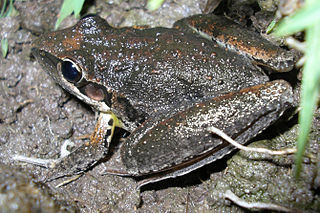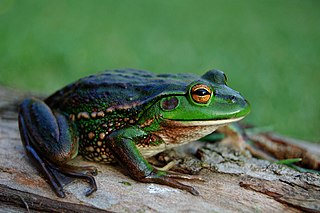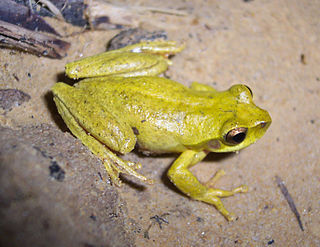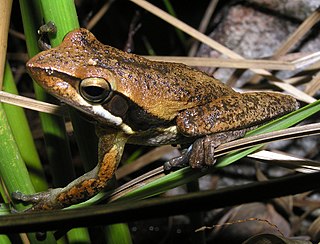
The eastern dwarf tree frog, also known as the eastern sedge-frog, is a species of tree frog. It is a small and very common frog and found on the eastern coast of Australia, from around Cairns, Queensland, to around Ulladulla, New South Wales. Individual frogs of this species are often found elsewhere, having been accidentally relocated by transported fruit boxes. Confirmed sightings of breeding pairs have confirmed their survival in Victoria's cooler climate.

Ranoidea chloris, commonly known as the red-eyed tree frog or orange-eyed tree frog, is a species of tree frog native to eastern Australia; ranging from south of Sydney to Proserpine in mid-northern Queensland.

The white-lipped tree frog is found in Australia and is the world's largest tree frog. Other common names include the New Guinea treefrog, giant tree frog, and Australian giant treefrog.

The magnificent tree frog, also known as the splendid tree frog, is a tree frog species first described in 1977. It has a limited range, only occurring on the north-western coast of Australia in the Northern Territory and Western Australia. It has a similar appearance to, and can be confused with, the closely related White's tree frog.

Tyler's tree frog or the southern laughing tree frog is an arboreal species of tree frog. It is native to eastern Australia where it occurs from south-eastern Queensland to the southern coast of New South Wales. It is generally a coastal species and is not found inland.

The broad-palmed frog is a species of ground-dwelling tree frog. It is native to much of eastern Australia. They can be found from mid-Queensland to south of Sydney. It is associated with the coast and inland, and is distributed as far west in New South Wales to the South Australia border.

The growling grass frog, also commonly known as the southern bell frog, warty swamp frog and erroneously as the green frog, is a species of ground-dwelling tree frog native to southeastern Australia, ranging from southern South Australia along the Murray River though Victoria to New South Wales, with populations through Tasmania. This species' common names vary between states; the name southern bell frog applies to New South Wales, growling grass frog in Victoria and South Australia, and green and gold frog in Tasmania. This species has been introduced to New Zealand.

Freycinet's frog, also known as the wallum rocket frog, is a species of frog. It inhabits coastal areas from Fraser Island, Queensland, south to the Jervis Bay Territory of New South Wales.

The Jervis Bay tree frog, also known as the curry frog in reference to its odour, is a species of Australian frog associated with wallum swampland along the east coast of New South Wales; ranging from the Queensland border to eastern Victoria.

The Blue Mountains tree frog also called the Variegated River Tree Frog is a species of tree frog in the family Pelodryadinae. It is endemic to southeastern Australia and is found in eastern Victoria and in southeastern New South Wales. The Jenolan Caves tree frog, a population formerly separated as Litoria jenolanensis, is nowadays included in this species.

The leaf green tree frog is a species of stream-dwelling frog, native to eastern Australia from the Queensland/New South Wales border south to Sydney.

The whistling tree frog (Litoria verreauxii), or Verreaux's tree frog, is a species of frog found in Australia. It has been divided into two subspecies, the nominate Verreaux's tree frog and the Verreaux's alpine tree frog. The alpine tree frog is restricted to the southern alps of New South Wales and Victoria. Verreaux's tree frog is widespread throughout south-eastern Queensland, coastal and highland regions of New South Wales, and south-eastern Victoria.

The revealed tree frog, also known as revealed frog, whirring tree frog, and orange-thighed treefrog, is a species of tree frog native to coastal eastern Australia.

The southern brown tree frog, also known as the brown tree frog, whistling tree frog, or Ewing's tree frog, is a species of tree frog native to Australia: most of southern Victoria, eastern South Australia, southern New South Wales from about Ulladulla—although this species is reported to occur further north—and throughout Tasmania including the Bass Strait Islands, in which state it is the most frequently encountered frog. It has been introduced to New Zealand, where it can be locally abundant.

The mountain stream tree frog is a species of tree frog native to highland areas of NSW, Australia stretching from the Myall Lakes area, north to around Dorrigo National Park and west to Barrington Tops National Park.

The dainty green tree frog, also known as the graceful tree frog, is a tree frog native to eastern Queensland, and north-eastern New South Wales, Australia. It ranges from northern Cape York in Queensland to Gosford in New South Wales, with a small and most likely introduced population in Hornsby Heights in Sydney. It is the faunal emblem of the City of Brisbane.

The striped rocket frog, or in its native range known as the rocket frog, is a species of frog that occurs mostly in coastal areas from northern Western Australia to around Gosford in New South Wales at its southernmost point, with a disjunct population occurring further south at the Sydney suburb of Avalon. It also inhabits the southern lowlands and south east peninsula of Papua New Guinea.

Littlejohn's tree frog, also called a heath frog or orange-bellied tree frog, is a species of tree frog native to eastern Australia from Wyong, New South Wales, to Buchan, Victoria.

The Booroolong frog is a species of stream-dwelling frog native to the Great Dividing Range in New South Wales.

The slender tree frog is a tree frog native to south-western Australia.























